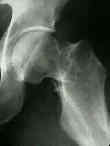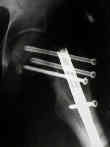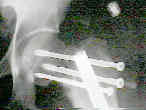 - See:
- See:- Femoral Neck Frx
- Discussion:
- these injuries occur from high energy trauma and comprise 1-6% of all femoral shaft frx;
- in up to 20% of cases, this injury is missed, which is often due to failure to take good quality femoral neck radiographs (often the hip is externally rotated which may obscure the fracture line);
- risk factors for femoral neck/shaft fractures include the presence of acetabulum and patellar fracture;
- when there is a question of a femoral neck fracture consider a CT scan of the femoral neck;
- in the retrospective series by Yang KH, et al, 6 of 8 undisplaced femoral neck fractures were shown to be present before operation (two fractures were iatrogenic);
- Fracture of the ipsilateral neck of the femur in shaft nailing. The role of CT in diagnosis.
- Treatment Options:
- priority should be given to anatomical reduction & rigid fixation of the fracture of the neck;
- if feasible, both fractures should be rigidly stabilized, with closed interlocking nailing being preferred for the fracture of the shaft;
- retrograde nailing of femoral shaft fractures:
- main disadvantage is possible knee stiffness;
- plating of femoral fractures
- miss a nail technique:
- main disadvantages involve the influence of the nail interfering with the reduction and interfering with the femoral head blood supply which might increase the chance of AVN
Ipsilateral fractures of the femoral neck and shaft.
Ipsilateral hip and femoral shaft fractures.
Femoral shaft fractures complicated by fracture-dislocations of the ipsilateral hip.
Ipsilateral concomitant fractures of the hip and femoral shaft.
Ipsilateral femoral neck and shaft fractures.
Fracture of the ipsilateral neck of the femur in shaft nailing. The role of CT in diagnosis.




